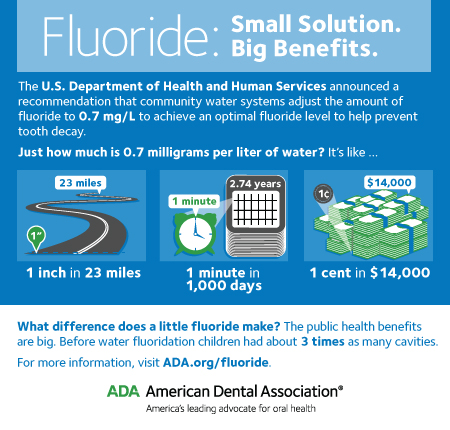From the Mouth Healthy ADA American Dental Association
http://www.mouthhealthy.org/en/az-topics/f/fluoridation
Fluoridation
Adding fluoride to public water supplies is a safe and effective way to prevent tooth decay and has played a major role in in improving the public’s dental health for 70 years. "Fluoride’s effectiveness in preventing tooth decay extends throughout one’s life, resulting in fewer—and less severe̵—cavities," says Surgeon General Vivek H. Murthy. Read on to learn more about what the Centers for Disease Control and Prevention (CDC) has proclaimed as one of 10 great public health achievements of the 20th century.
What Is Community Water Fluoridation?
Fluoridation of community water supplies is simply the adjustment of the existing, naturally occurring fluoride in drinking water to an optimal level for the prevention of tooth decay. Think of it this way: Water that has been fortified with fluoride is similar to fortifying milk with Vitamin D, table salt with iodine, and bread and cereals with folic acid.
The number of communities who make the choice to fluoridate their water continues to grow. From 2000-2014, more than 449 U.S. communities in 42 states have voted to adopt or retain successful fluoridation programs. The latest data show that in 2012, 74.6% of the U.S. population on public water systems, or a total of 210.7 million people, had access to optimally fluoridated water.
How Much Fluoride Is Recommended In Community Water Systems?
It is recommended that community water systems adjust the amount of fluoride to .7 milligrams per liter of water. Use the chart below to see what that amount is equivalent to.
5 Reasons Why Fluoride in Water is Good for Communities
- Prevents tooth decay. Fluoride in water is the most efficient way to prevent one of the most common childhood diseases – tooth decay. An estimated 51 million school hours are lost each year due to dental-related illness, and one study has shown that children who live in communities without fluoridation are three times more likely to end up in the hospital to undergo dental surgery.
- Protects all ages against cavities. Studies show that fluoride in community water systems prevents at least 25 percent of tooth decay in children and adults, even in an era with widespread availability of fluoride from other sources, such as fluoride toothpaste. Why fluoride is called nature's cavity fighter.
- Safe and effective. For 70 years, the best available scientific evidence consistently indicates that community water fluoridation is safe and effective. It has been endorsed by numerous U.S. Surgeons General, and more than 100 health organizations recognize the health benefits of water fluoridation for preventing dental decay, including the Centers for Disease Control and Prevention, the American Medical Association, the World Health Organization and the American Dental Association.
- Saves money. When it comes to the cost of treating dental disease, everyone pays. Not just those who need treatment, but the entire community – through higher health insurance premiums and higher taxes. The average lifetime cost per person to fluoridate a water supply is less than the cost of one dental filling. For most cities, every $1 invested in water fluoridation saves $38 in dental treatment costs.
- It’s natural. Fluoride is naturally present in groundwater and the oceans. Water fluoridation is the adjustment of fluoride to a recommended level for preventing tooth decay. It’s similar to fortifying other foods and beverages, like fortifying salt with iodine, milk with vitamin D, orange juice with calcium and bread with folic acid.
If you have specific questions about your family’s fluoride needs, please contact your family dentist, pediatrician or physician.
Next: Why fluoride is like a superhero in your mouth >>
For additional information on fluoridation visit:
- American Dental Association's Fluoridation Facts: An encyclopedia of fluoridation information in question and answer format
- The ADA's Fluoride and Fluoridation Website: General information on fluoridation
- My Water’s Fluoride: Learn if your public water system is fluoridated

